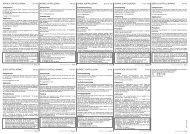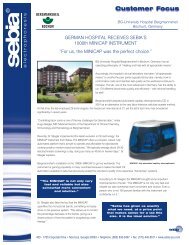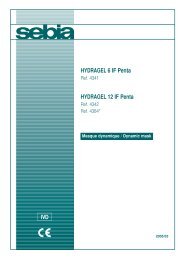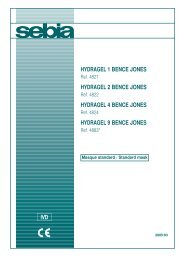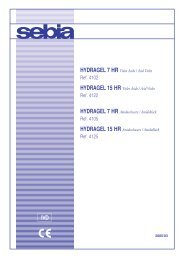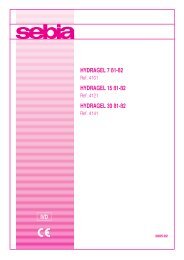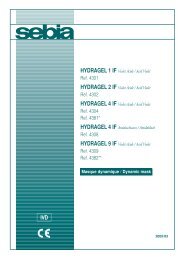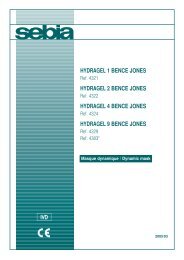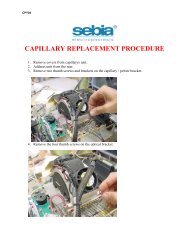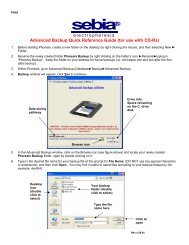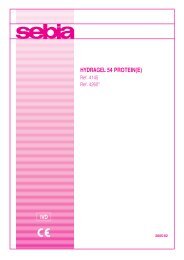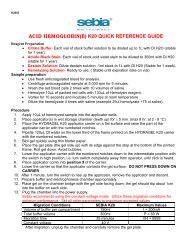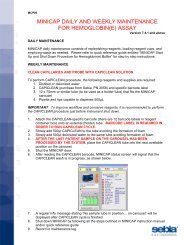CAPILLARYS HEMOGLOBIN(E)
CAPILLARYS HEMOGLOBIN(E) - Sebia Electrophoresis
CAPILLARYS HEMOGLOBIN(E) - Sebia Electrophoresis
- No tags were found...
Create successful ePaper yourself
Turn your PDF publications into a flip-book with our unique Google optimized e-Paper software.
<strong>CAPILLARYS</strong> <strong>HEMOGLOBIN</strong>(E) - 2010/10<br />
SAMPLES FOR ANALYSIS<br />
Sample collection and storage<br />
Fresh anticoagulated blood samples are recommended for analysis. Common anticoagulants such as those containing EDTA, citrate or heparin are<br />
acceptable ; avoid those with iodoacetate. Blood must be collected according to established procedures used in clinical laboratory testing.<br />
Samples may be stored for up to 7 days between 2 and 8 °C.<br />
For longer storage, samples can be frozen at - 80 °C within 8 hours of collection after having washed the red blood cells according to the following<br />
procedure: Centrifuge anticoagulated blood at 5 000 rpm for 5 minutes ; discard the plasma; wash the red blood cells (RBC) 2 times with 10 volumes<br />
of saline (centrifuge after each washing step) ; discard the excess of saline over the red blood cells pellet and vortex them before freezing.<br />
Frozen blood samples are stable for 3 months maximum at - 80 °C.<br />
IMPORTANT: For optimal storage of blood samples, store them at - 80 °C. Do not store at - 20 °C (see BIBLIOGRAPHY, J. Bardakdjian-Michau et al,<br />
2003).<br />
NOTE: Samples should not be stored at room temperature!<br />
Progressive hemoglobins (Hb) degradation may occur for samples stored between 2 to 8 °C.<br />
When the blood sample is stored for more than 7 days at 2 - 8 °C:<br />
• a weak fraction, corresponding to methemoglobin, appears in the Hb S migration zone,<br />
• when Hb C is present, a fraction corresponding to degraded Hb C appears more anodic than Hb A2 which does not interfere with it (Z4 zone, see<br />
the table in paragraph "Interpretation"),<br />
• when Hb O-Arab is present, a fraction corresponding to degraded Hb O-Arab appears in the Hb S migration zone (Z5 zone, see the table in<br />
paragraph "Interpretation"),<br />
• when Hb E is present, a fraction corresponding to degraded Hb E appears in the Z6 zone (see the table in paragraph "Interpretation"),<br />
• when Hb S is present, a fraction corresponding to degraded Hb S appears in the Hb F migration zone (Z7 zone, see the table in paragraph<br />
"Interpretation"),<br />
• when Hb A is present, a fraction corresponding to degraded Hb A ("aging fraction" of Hb A) appears more anodic (Z11 zone, see the table in<br />
paragraph "Interpretation").<br />
When Hb F is present (in blood samples from newborn babies), a fraction appears in the Hb A migration zone (Z9 zone, see the table in paragraph<br />
"Interpretation") due to the sample degradation.<br />
When stored for more than 10 days, viscous aggregates in red blood cells are observed; it is necessary to discard them before the analysis.<br />
Sample preparation<br />
• Let red blood cells precipitate for several hours at 2 - 8 °C or centrifuge the blood sample at 5 000 rpm for 5 minutes.<br />
• Discard carefully the maximum volume of plasma (for samples collected with heparin, discard viscous aggregates located between plasma and red<br />
blood cells).<br />
• Vortex for 5 seconds.<br />
IMPORTANT: Do not use blood samples containing 3 mm maximum residual plasma over red blood cells; when more than 3 mm plasma is present<br />
in the tube, the analysis should be affected.<br />
Particular cases: Analysis of samples without any Hb A or Hb A2 (these samples are perfectly quantified but not identified by zones).<br />
To identify hemoglobin fractions of a sample without any hemoglobin A or hemoglobin A2, it is recommended to prepare this sample according to one<br />
of the two following procedures:<br />
Automatic dilution:<br />
- In a microtube, mix one volume (80 µL) of red blood cells from the sample to analyze with one volume of Normal Hb A2 Control (80 µL).<br />
- Vortex for 5 seconds.<br />
- Cut the cap of the microtube.<br />
- Place the microtube, on a new hemolysing tube used as a support-tube, on a sample rack of the <strong>CAPILLARYS</strong> system.<br />
- Perform the analysis of this sample according to the standard procedure like a usual blood sample.<br />
Manual dilution:<br />
- Apply, directly in the wells of a new green dilution segment, 9 µL of reconstituted Normal Hb A2 Control with 9 µL of blood sample to analyze and<br />
90 µL of <strong>CAPILLARYS</strong> <strong>HEMOGLOBIN</strong>(E) hemolyzing solution.<br />
- Mix by repeated pipettings.<br />
- Place this dilution segment on the sample rack No. 0 of <strong>CAPILLARYS</strong>.<br />
- Slide the sample rack into the <strong>CAPILLARYS</strong> system, select "Sample" with "manual dilution" in the window which appears on the screen and validate.<br />
The results are then automatically considered by the software for the data analysis.<br />
IMPORTANT: For a sample without any Hb A or Hb A2 prepared according to one of these two procedures, the result obtained with the mixed sample<br />
will enable presumptive variant identification due to the positioning of the hemoglobins fractions in the appropriate identification zones. Do not report<br />
the relative quantification from the mixed sample result.<br />
The relative quantification of hemoglobins should be reported utilizing the initial, unmixed sample result (without any dilution in the blood control).<br />
Samples to avoid<br />
• Do not use unsedimented blood samples.<br />
• Avoid aged, improperly stored blood samples ; the automated hemolysis of samples may be disturbed by viscous aggregates in red blood cells.<br />
Then, degradation products (as artefacts) may affect the electrophoretic pattern.<br />
PROCEDURE<br />
The <strong>CAPILLARYS</strong> system is a multiparameter instrument for hemoglobins analysis on parallel capillaries. The hemoglobins assay uses 7 of the total<br />
8 instrument capillaries to run the samples.<br />
The sequence of automated steps is as follows:<br />
• Bar code reading of sample tubes (for up to 7 tubes) and samples-racks ;<br />
• Sample hemolysis and dilution from primary tubes (without any plasma) into dilution segments ;<br />
• Capillary washing ;<br />
• Injection of hemolyzed samples ;<br />
• Hemoglobin separation and direct detection of the separated hemoglobins on capillaries.<br />
- 38 -



